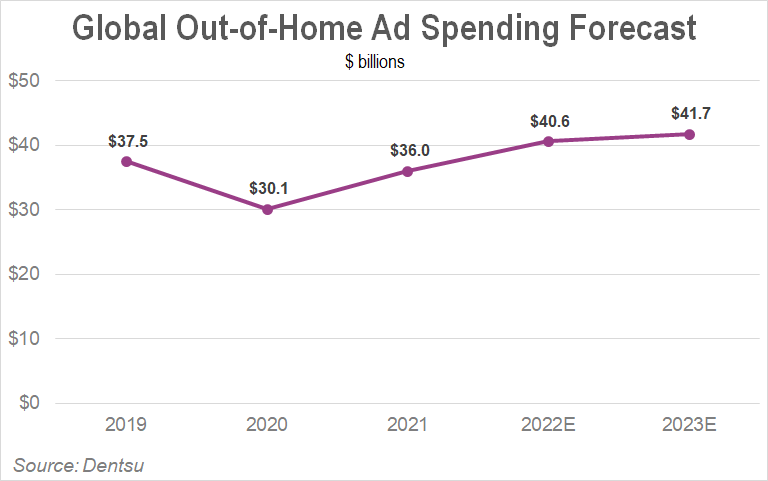Out-of-home advertising is rebounding as marketers seek to reach consumers who are itching to get back to pre-pandemic activities like traveling, going out to eat, attending live events and shopping in stores. Brands also are relying on software tools to improve their targeting and contextual messaging amid the challenges of losing tracking cookies and device identifiers in their digital efforts.
Consumers “appreciate out-of-home more than they ever have,” Anna Bager, president and chief executive of the Out of Home Advertising Association of America (OAAA), said in this interview with Beet.TV. “They see our ads, they interact with them and they get inspired by them.”
Digital Out of Home, Programmatic Buying
Four out of 10 consumers said they had noticed outdoor ads more now than they had before the global pandemic, according to a consumer study the association conducted with the Harris Poll. The global health crisis led to a downturn in outdoor media spending, but the industry has worked to reinvent itself with different kinds of technology, Bager said.
“The pandemic in a sense served us well,” she said. “The pandemic gave the industry — that was sort of embarking on a digital transformation — the opportunity to really start thinking about how to build this out the right way, and how to integrate digital and programmatic more into our transactions.”
Digital out-of-home (DOOH) installments that rotate images and video in places like transit terminals and areas with high traffic have become more popular amid the advancements in high-speed cellular networks. Programmatic buying that lets advertisers bid for outdoor media placements also is a major source of growth.
“We are about signage and screens, and with 5G, better screen technology, and consumers hitting the streets again,” Bager said. “The opportunity to create advertising with sound and motion, or just motion, is massive. Consumers respond well to it.”
Outdoor advertising also lets marketers reach consumers with focused messaging based on geographic locations, weather forecasts and other data signals.
“Out of home is about content and context and location,” Bager said. “In today’s world when it’s harder and harder to target based on data — there’s restrictions around privacy and there’s restrictions around mobile data — out-of-home really lends itself well to contextual targeting solutions.”
QR Codes, Non-Fungible Tokens
Quick-response (QR) codes let consumers scan an outdoor ad with a smartphone camera to see more information about a brand, or to respond to a call-to-action. Outdoor advertisers also can use promote sales of digital assets such as non-fungible tokens (NFTs) that act as a proof of ownership.
“Out-of-home is for a long time been viewed as a brand-building medium, but it’s not. It’s great for driving performance and conversion,” Bager said. “NFTs, QR codes and other forms of technology that we now have access to — and that consumers are used to — are very exciting. It’s going to help take our medium into the future.”
You are watching “Advertising Transformation: What’s Next for Converged TV and Video,” a Beet.TV Virtual Leadership Summit presented by Mediaocean. For more videos, please visit this page.















































